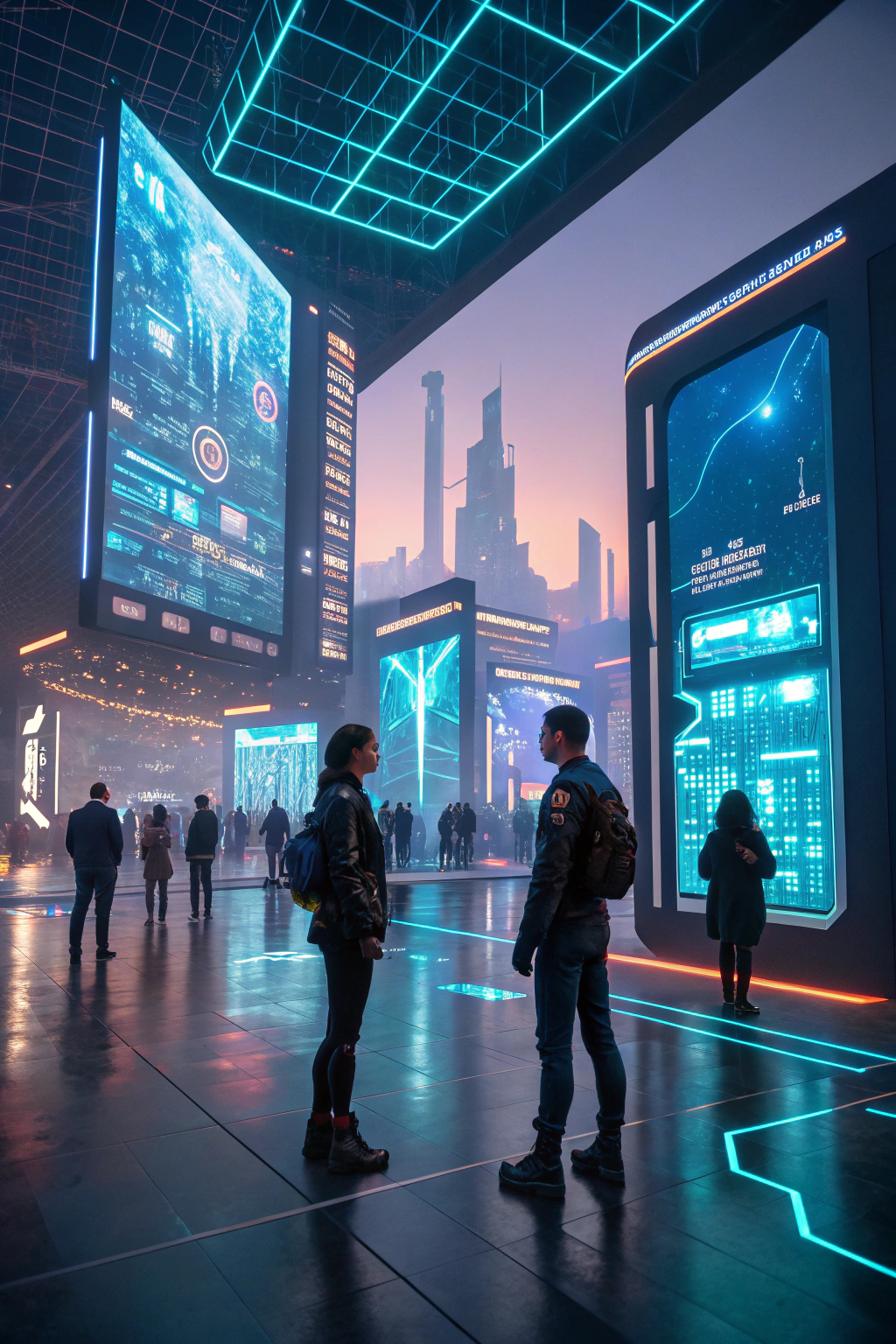or ‘ the ‘, so for example, instead of ‘The Introduction’, write ‘Introduction’
Introduction
From the simple text-based forums of the early internet to the sprawling, graphically rich metaverses of today, virtual communities have constantly evolved. The next seismic shift is already underway, driven by a technology poised to redefine digital interaction as we know it. We are entering an era where the lines between human and artificial, scripted and spontaneous, begin to blur. This transformation is at the core of Neural AI and the Future of Virtual Communities, a convergence that promises to create online spaces that are more dynamic, immersive, and intelligently responsive than ever before. This isn’t just about better chatbots; it’s about building living, breathing digital societies.
Background and Evolution of Neural AI and the Future of Virtual Communities
The concept of artificial intelligence in digital worlds is not new. For decades, video games have used « AI » to control non-player characters (NPCs), but these were largely simple, rule-based systems following predictable scripts. The revolution began with the rise of neural networks—complex algorithms modeled on the human brain that can learn from vast amounts of data. Initially applied to tasks like image recognition and language translation, their power is now being unleashed within virtual environments.
This evolution from rigid, pre-programmed logic to adaptive, learning systems marks a monumental leap. Instead of an NPC that can only repeat a few lines of dialogue, we now have the potential for characters who remember past interactions, understand conversational nuance, and generate unique responses. As tech platforms grapple with creating more engaging digital worlds, neural AI provides the engine for that engagement. This shift mirrors a broader trend in technology, where AI is becoming increasingly integrated into the fabric of our mainstream digital lives, moving from a background process to a central feature of the user experience.
Practical Applications of 26.1
Use Case 1: Hyper-Immersive Narrative and World-Building
Imagine a massive multiplayer online game where the world’s story isn’t written by developers but evolves based on the collective actions of its players. Neural AI can act as a « dungeon master, » observing player behavior and dynamically generating new quests, characters, and even entire storylines in real-time. If a group of players decides to build a new settlement in a remote wilderness, the AI could populate it with merchants who respond to the local economy, create environmental challenges like droughts or monster attacks, and introduce political conflicts with neighboring player-run factions. This turns a static game world into a living, breathing ecosystem where player agency has a genuine, unscripted impact.
Use Case 2: Advanced Social Moderation and Community Health
One of the greatest challenges for any large online community is moderation. Human moderators can be overwhelmed, and traditional keyword-based bots lack the ability to understand context. Neural AI offers a more nuanced solution. It can be trained to recognize not just profanity, but also subtle forms of harassment, coordinated misinformation campaigns, and the emotional sentiment of conversations. This allows it to flag potentially toxic behavior for human review or even take initial steps to de-escalate a heated discussion by suggesting a cool-down period. The goal of this application of Neural AI and the Future of Virtual Communities is to foster safer, more inclusive, and psychologically healthier online spaces.
Use Case 3: Personalized Companionship and Assistance
Beyond gaming, virtual communities in social VR and the metaverse can benefit from AI companions. These aren’t just simplistic virtual pets; they are personalized assistants and friends powered by neural AI. An AI companion could learn your interests and suggest new virtual experiences or people to meet. It could help a new user navigate a complex virtual world, acting as a friendly guide. For communities focused on learning or wellness, an AI could serve as a personalized tutor or a supportive coach, providing encouragement and tracking progress. This creates a more welcoming and supportive environment, especially for users who might otherwise feel isolated.
Challenges and Ethical Considerations
The integration of neural AI into our digital social lives is not without significant risks. A primary concern is algorithmic bias. If an AI is trained on biased data from the internet, it can learn to perpetuate and even amplify harmful stereotypes, potentially leading to unfair moderation or exclusionary virtual environments. Privacy is another major hurdle; for an AI to create a truly personalized experience, it must collect and analyze vast amounts of user data, raising questions about consent, security, and how that information is used.
Furthermore, the rise of hyper-realistic AI-driven characters and content introduces a new vector for misinformation and manipulation. Malicious actors could deploy sophisticated AI agents to spread propaganda, sow discord within a community, or engage in fraudulent activities that are nearly indistinguishable from genuine human interaction. Establishing clear regulatory frameworks and ethical guidelines is paramount to ensure that the development of Neural AI and the Future of Virtual Communities prioritizes user well-being and societal health over pure technological advancement.
What’s Next for Neural AI and the Future of Virtual Communities?
The pace of innovation is staggering. In the short term, we will see increasingly sophisticated NPCs in mainstream video games, powered by platforms like Inworld AI, that offer far more dynamic and believable interactions. In the mid-term (3-5 years), expect to see the first persistent, AI-orchestrated virtual worlds where the environment and narrative are constantly evolving. These platforms will move beyond gaming into social and professional collaboration spaces.
Looking further into the long-term, the ultimate goal is a seamless fusion with augmented and virtual reality. Imagine AI agents that can exist as persistent entities within our AR-enhanced physical world, acting as guides, assistants, or companions that bridge our digital and physical communities. The focus will shift from creating simulated intelligence to building symbiotic intelligence that enhances human connection and creativity.
How to Get Involved
Stepping into this evolving world doesn’t require a PhD in computer science. You can start by exploring platforms like Character.ai to experience conversational AI firsthand. For those interested in the development side, joining Discord or Reddit communities focused on AI in gaming or metaverse platforms provides direct access to creators and discussions. Following the research from labs like OpenAI and DeepMind offers a high-level view of where the technology is headed. To explore a curated list of resources and connect with fellow enthusiasts, check out our hub for guides and community links.
Debunking Common Myths
Myth 1: AI will make virtual worlds feel lonely and fake.
Clarification: The objective is not to replace human players with bots, but to use AI to enrich the environment. Well-designed neural AI makes the world feel more alive and reactive, creating more compelling reasons for human players to interact with each other and the world itself.
Myth 2: You need to be a programmer to interact with neural AI.
Clarification: Most modern applications are designed for seamless user interaction via natural language. You talk or type to the AI just as you would with a person. The complexity is all under the hood, enabling intuitive experiences for everyone.
Myth 3: AI-driven NPCs are basically just advanced chatbots.
Clarification: While they both use language models, a neural AI-powered NPC is far more integrated. It possesses memory, understands context within the virtual world, has objectives, and can perceive and react to its environment, making it a true agent rather than just a conversational interface.
Top Tools & Resources for Neural AI and the Future of Virtual Communities
- Inworld AI: A powerful developer platform that allows creators to build intelligent, emotionally resonant NPCs for games and virtual experiences. It’s a key tool for anyone looking to bring dynamic characters to life.
- Character.ai: A user-friendly, web-based platform where anyone can create and chat with AI-powered characters. It’s an excellent sandbox for understanding the possibilities and limitations of current conversational AI.
- Blender: This free and open-source 3D creation suite is essential for building the assets and environments that make up virtual communities. When combined with AI plugins, it becomes a powerhouse for generating dynamic virtual worlds.

Conclusion
The fusion of neural AI and virtual communities is more than just a technological trend; it’s the dawn of a new paradigm for human interaction. It holds the potential to create digital spaces that are more engaging, supportive, and creatively liberating than anything we’ve experienced before. However, realizing this potential requires a mindful and ethical approach, addressing the challenges of bias, privacy, and manipulation head-on. The journey is just beginning, and it’s one that will be shaped by creators, users, and thinkers alike. The future isn’t just something we will log into; it’s something we will build together. 🔗 Discover more futuristic insights on our Pinterest!
FAQ
What is Neural AI and the Future of Virtual Communities and why is it important?
This term describes the integration of advanced, brain-inspired artificial intelligence into online social platforms, games, and metaverses. It’s important because it allows for the creation of dynamic, persistent, and deeply interactive digital environments with intelligent characters and systems, fundamentally changing how we socialize, play, and connect online.
How can I start using Neural AI and the Future of Virtual Communities today?
The easiest way to start is by engaging with consumer-facing platforms. Try services like Character.ai to chat with different AI personalities or play modern video games that are beginning to incorporate more advanced, dynamic NPC behaviors. This provides a direct, hands-on feel for the technology’s capabilities.
Where can I learn more?
To learn more, you can follow the official blogs of AI research companies like DeepMind and OpenAI, join subreddit communities like r/virtualreality or r/singularity, and explore developer platforms like Inworld AI to see how these systems are built. Tech news sites also frequently cover major breakthroughs in this space.
